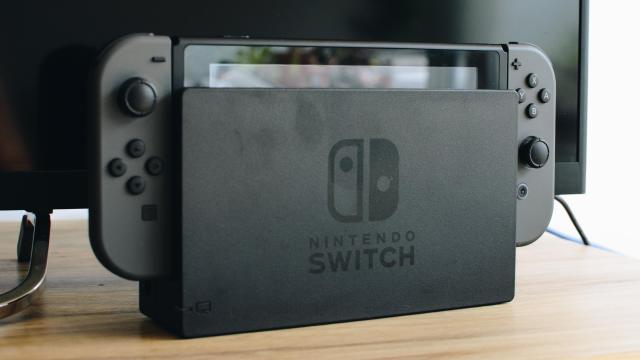The brilliance of the Nintendo Switch is how it gives you the ability to go from playing a game handheld to experiencing it on your big screen in seconds. That brilliance is certainly dimmed, however, if you have to deal with intermittent blackouts on your TV. If you’re experiencing this issue with your Switch, there are two things you should know: You’re not alone, and there’s a solution.
Reddit user r/Ramen-Noodle-Bear had this problem. They were struggling to figure out why their OLED Switch would occasionally serve up a black screen for about four to five seconds at a time when plugged into their LG C9 OLED TV. During these blackouts, there was no sound, but the Switch’s handheld display didn’t kick in either: the console still recognised it was docked. In addition, Ramen-Noodle-Bear’s Joy-Cons still worked during these image interruptions, suggesting the system remained awake throughout.
As a biomedical equipment technician in their offline life, Ramen-Noodle-Bear claims to be well-versed in troubleshooting, and proceeded to try and test every variable under the sun. They fully updated the firmware for both the TV and the Switch; they ensured the TV wasn’t just turning off, switching inputs, or adjusting HDR settings; they promise, “if you read anywhere something that someone tried, I’ve done it.”
The fix: a new HDMI cable
Luckily, Ramen-Noodle-Bear eventually stumbled upon the solution, saving their sanity as well as the sanities of anyone experiencing these Switch blackouts: You need to switch (heh) to an HDMI 1.4 cable.
You see, Nintendo packed an HDMI 2.0 cable with the OLED Switch, to match the output port, which was also upgraded to the new standard. The Switch apparently can handle both HDMI 1.4 and HDMI 2.0, meaning you should see no difference in gameplay or performance using one over the other. However, for some reason, the newer standard can result in maddening blackouts with the video output, especially with this particular LG TV.
It’s difficult to say why HDMI 2.0 can cause this handshake issue while HDMI 1.4 does not: it’s possible there’s a mild incompatibility between LG’s C9 TV and the Switch’s HDMI 2.0 output. Ramen-Noodle-Bear theorizes the issue might lie in 2.0’s increased maximum data output of 18 gbps over 1.4’s 10.2 gbps, even though those theoretical maximums have no additional impact on gameplay or performance. That said, HDMI 2.0 isn’t a new technology — it’s been around since 2015 — so an incompatibility with a new TV is odd.
Whatever the cause, swapping that 2.0 cable for a 1.4 cable does the trick, and it’s a cheap fix: You can find plenty of cable options on Amazon for under $US10 ($14). Ramen-Noodle-Bear isn’t alone in encountering this problem or trying out this solution: The top comment on their Reddit thread describes the same issue with the same TV and Switch models, with others echoing similar sentiments and thanking Ramen-Noodle-Bear for the solution.
Another possible solution
That said, other Redditors reported suffering from blackouts while using different hardware, and found a different solution to solve the problem. These gamers were using a launch-day Switch rather than an OLED model, and experienced issues while docked to a Samsung TV. The fix for them required changing their TV’s RGB settings to “Limited Spectrum.” If your problem aligns with this hardware setup, try changing that setting before buying a new cable.
You’d think we would’ve figured out these A/V issues by now. Alas, as long as we’re connecting together devices from two different companies, occasional incompatibilities are to be expected. Maybe Nintendo should just make its own TVs.

Leave a Reply
You must be logged in to post a comment.